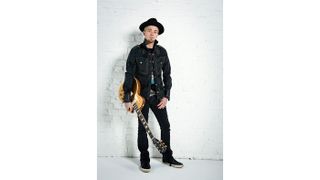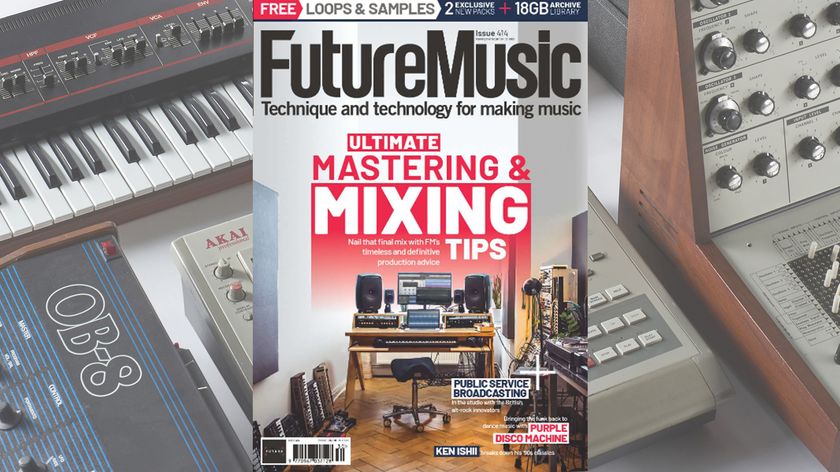Black Stone Cherry: “We don’t even know that many scales. We came up with our identities through trial and error”
Ben Wells and Chris Robertson discuss Family Tree and their guitar-playing evolution

While their story began in the muddier waters of heavy biker rock some 17 years ago, Kentucky quartet Black Stone Cherry could very well be regarded today as righteous contemporary messengers of the blues for a whole new generation.
Last year’s Black To Blues EP saw them reimagining the works of Freddie King, Albert King and Willie Dixon - and naturally a healthy dose of that spirit has spilled over into the sounds heard on this year’s sixth full-length Family Tree. Having grown up surrounded by swamp music in the Deep South, with blood links to local heroes The Kentucky Headhunters through drummer John Fred Young, few could deny this is a family tree worth exploring. And their story continues to unfold; the arena rockers’ hard work paying off by denting the UK Top 10 album charts for the third time in their career.
Reuniting once again in their home state with David Barrick - the man who produced their Roadrunner Records debut - the anthems of their latest venture were most certainly a product of their environment, as their guitar duo, frontman Chris Robertson and bandmate Ben Wells explain…
Our engineer told me, ‘Man, it’s really good, it’s really clean… but it sucks!’
It’s interesting to hear how much you’ve grown as a slide player on this record, Chris, what has the journey been like to get there?
Chris: “Well, I hate playing slide live, because it’s hard for me standing up. Any slide on our records has usually been me, but always sat down. On the blues EP, I figured out the trick to slide. We were recording the last song and our engineer told me, ‘Man, it’s really good, it’s really clean… but it sucks!’ I was a bit surprised! But then he told me it sounded like I wasn’t having any fun, it was like I was concentrating on every note. So I started doing the big shake like Ry Cooder, that really wide vibrato, and that’s when it all opened up for me. There’s a great slide guy from Kentucky people need to check out called Boscoe France. He’s an absolute monster guitar player. He does what Sonny Landreth does, which is playing behind the slide as well… it’s incredible. He also knows how to do the Derek Trucks thing, where you get Middle-Eastern sounds and that whole sitar vibe.”
Ben: “Derek Trucks is probably the best player on the planet right now! He makes it look effortless, you’ll never see him mess up. He takes a lot of influence from Duane Allman and plays it so beautifully, sometimes I think I couldn’t even try to do that.”
Even beyond the slide, there is a stronger Allman Brothers influence coming through on Family Tree - it feels like there are more harmonised dual leads in major keys on this record…
Get the MusicRadar Newsletter
Want all the hottest music and gear news, reviews, deals, features and more, direct to your inbox? Sign up here.
Chris: “I know guys that can automatically re-pitch to make harmonies in their heads. We’re self-taught dudes. I can’t read sheet music, I don’t know what a third or a fifth is… all I know is the I-IV-V, which I learned from the blues. That’s about it. My dad showed me where rock’n’roll minor pentatonics were in E. And after that he showed me what I call the country box, saying if I wanted to sound like Ramblin’ Man by the Allman Brothers, I had to take it down three frets to C sharp.
“That song is in G… but you play the whole song in E. All of those same licks sound happy all of a sudden! I always think there are two different routes: the Allman Brothers way or the Thin Lizzy way. That’s how we relate to it in our heads, but if we can’t find it we’ll sit there literally going one note at a time with two guitars until we have found the right ones.”
Ben: “There are no egos in our band. If one guy does it better, then that’s who should do it. Any acoustic stuff or clean picking arpeggiated stuff has always been my bag. Chris always says it’s because he has bigger fingers so he can’t get around like that, while mine are smaller. I love playing acoustic and doing the cleaner things.”
Breaking down walls
How does a band like Black Stone Cherry go about getting more mileage out of the blues scale - do you ever feel like you’re hitting brick walls?
Ben: “Chris and I don’t even know that many scales. We came up with our identities through trial and error. We’d listen to stuff and learn how to play it, figuring out all the different tunings. Some people are more taught - but I don’t think I could play you five scales right now if you asked! Every player is different.
I have also been putting more time into catching other strings when I bend
“I was talking to Rickey Medlocke from Skynyrd about this once and he was the same. He said, ‘I can’t read music, all I did was figure it out, you mess it up and need to figure out why it doesn’t sound right!’ Simple as that. I like mixing the happy scales and the minor ones. You can start minor pentatonic and switch it up into major, it makes people’s heads turn. If you do it well, they’ll never see you coming! It’s good to intermix the southern rock, country and blues… I like it all put together.”
Chris: “I’ve been there too, when you just feel like you are playing the same things over and over again. But if you watched someone like BB King, who could hold one note that lasts three minutes with this beautiful vibrato and that was able to say more than a thousand notes.”
Are there any new licks you’ve been focusing more on recently? There are some chromatic walkdown leads on the album that sound quite jazz school…
Chris: “Those chromatic lines you hear are when I don’t know how to change the key, I just move down a half-step until it sounds right! I just played with my eyes closed and literally fell backwards musically. Recently, I’ve been working on a lick that incorporates a few extra notes in B - changing the direction of my pentatonic runs. I have also been putting more time into catching other strings when I bend, like when Hendrix would bend up on 15th fret of the second string and grab the fourth string at the same time before coming down or sliding back to the 12th. I find happy mistakes happen a lot!”
Ben: “We did a cover of Burning Love by Elvis, which is one of the B-sides, so I took the solo on that. I did it with my fingers, and it was a whole new world learning how to play without a pick. I put it down to challenge myself… there’s something magical about how rockabilly guys like Brian Setzer can do that.”
There’s modulation on the guitars of opening track Bad Habit that almost give the parts more of an organ feel. What were you using in the studio?
Chris: “That sound came from a Strymon Lex, which worked really well on the Hendrix-y parts I was playing there. It’s one of a couple of songs where I used a 1973 Strat - one of the old ones with a big fat headstock, three-bolt neck… which a lot of people don’t like, but I actually really love that guitar. I got it in San Antonio last year, I think you can really hear it cutting through on that song.”

Tonal character
Was the majority of the record cut with PRS and Gibson guitars?
Chris: “Yup, for the most part. PRS is all I use live, but in the studio I might use a couple of other things. For this album, I mainly stuck with a 594 Soapbar, the single-cut version. I don’t do doublecuts, they just don’t feel right to me. So a lot of the rhythms were done with that and then I had my signature guitars in there for a lot of the lead stuff.”
Ben: “I mainly stuck with a Les Paul Classic - I love the pickups that are in it, the 496 and the 500 in the bridge, which has a slightly higher output. I also used a Gretsch White Falcon and a new Gretsch Panther, which is like their answer to a 335. And there’s also a Telecaster on there too!
We always ask each other what we are going for with each song, because we don’t want to sound the same
“We always ask each other what we are going for with each song, because we don’t want to sound the same. It should be two individual players, producing two individual sounds. If people notice one side is Chris and the other is me, that’s great - that’s exactly what we’re going for: a big sound.”
What kind of amps did you entrust to deliver that fuller sound?
Chris: “Believe it or not, I didn’t use a single tube amp on the new record. It was all done using my Line 6 Helix, every single note. I only had the Lex in front and a Vox hand-wired wah, the one with a clear control plate on the bottom so you can see all the potentiometers and shit. The rest was all done in the Helix, there was no third party stuff, just whatever comes when you buy that thing!”
Ben: “I went through a Budda Superdrive 45 head. I had been using Peavey 6505s and loved how they sounded, but it turns out they own Budda now too. So I got to switch amps but stay with the same company, haha! My taste has gone from the oversaturated, high-output heavy distortion to less gain. I still love the crunch and girth, but I guess I felt like I was over it. Our band isn’t really that kind of band anyway. Chris used to play with Budda years ago, so when we got them the guitars sounded perfect. Everything was clean enough yet heavy enough, it was right down the middle.”
It’s interesting to hear the results of analogue and digital combined, along with single-coils and humbuckers, rather than being too purist about things…
Chris: “I was an amp snob for many years, but I also like to tweak shit. I change pickups on guitars at least twice a week when I’m at home, trying to find that perfect sound. I’ll get soldering whenever I’m in the house and bored as shit. I might put new ones in and swap them from one guitar to another, finding different combinations I liked.
“Even my ’73 Strat, I’ve changed the bridge pickup at least three times and eventually went back to the original one. The only ones I haven’t messed with are my signatures! The Helix lets you control everything. I live to tweak - changing the mic modeller from a U67 to a U87, or a R121 with a 57, or a 160 with some form of condenser. It’s so easy to change all that stuff. I’d make fun of all my buddies playing Axe-Fx and Kemper saying, ‘That’s a cool almost amp, man!’ Now I’ve used one for our last two releases!”

Tune it up
What other effects did you end up using? Interesting to hear a talkbox on Southern Fried Friday Night…
Ben: “Though we try not to overdo it with effects, I used a Rocktron Banshee talkbox for that. Not a lot of people know about that pedal, but I think it’s great because it allows you to use your amp and talkbox at the same time… you don’t need an external amp or speaker or anything. There’s also a Boss Super Octave with built-in fuzz that I used and I also had the MXR Sub Machine, which is easily one of the best I’ve ever played. It sounds so nasty and badass, and that’s exactly what I love about it!”
Whenever you’re sat around trying to write something but not feeling inspired, go to a different tuning
Chris: “In the Helix, I used the built-in Furby wah. You can set all the high and low frequencies, which gives you more options. And for the Bad Habit solo I used an Octavia similar to what Hendrix used with delay going into a 100-watt Super Lead Plexi with the channels jumped and four cabinets [all modelled] with two mic’d close and the others more like room mics. My tone is pretty dark, definitely darker than Ben’s. I like being able to control every single parameter… because I’m probably a control freak.”
You newer material is a less detuned than it used to be, how do you feel your approach has changed?
Chris: “Our Kentucky record had songs in B or drop A! The main guitars were standard scale [on this album], only a couple of extra tracks were done with baritones. I think there’s only one song, You Got The Blues, that utilises this drop tuning we like and used on Soulcreek and Devil’s Queen, which are both on our second album…”
Ben: “What you do is tune your guitar a full step down with a drop C, but further detuning the fifth string to F instead of G. It’s only dropping one extra string but suddenly you get this whole different vibe. It opens up new doors to different chords, it’ll change your flow of creativity too. Whenever you’re sat around trying to write something but not feeling inspired, go to a different tuning. That will be like a refresher, it will get you interested again and hopefully excite you into going in a new direction. That’s how those songs came about, just experimentation.
“These tunings can add different colours to your music, especially if one player is in standard and another is in open. You can complement each other in really interesting ways. The Black Crowes used a lot of open tunings, too… it just sounds really big. They were inspired by the '70s but still sounded contemporary, which is kinda what we’ve tried to do - we don’t want to sound like a throwback or a copycat band.”
Family Tree is out now via Mascot Records. Black Stone Cherry tour the UK in December - tickets are available now.
Amit has been writing for titles like Total Guitar, MusicRadar and Guitar World for over a decade and counts Richie Kotzen, Guthrie Govan and Jeff Beck among his primary influences. He's interviewed everyone from Ozzy Osbourne and Lemmy to Slash and Jimmy Page, and once even traded solos with a member of Slayer on a track released internationally. As a session guitarist, he's played alongside members of Judas Priest and Uriah Heep in London ensemble Metalworks, as well as handling lead guitars for legends like Glen Matlock (Sex Pistols, The Faces) and Stu Hamm (Steve Vai, Joe Satriani, G3).














